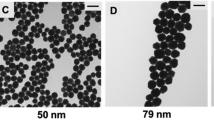Abstract
There has been increasing interest in the use of a nanoparticle-based media as a contrast-enhancement agent in medical imaging, particularly with gold Nanoparticles in radiography. Particularly attractive, is the prospect of modifying the surface of these materials with monoclonal antibodies to preferentially bind the nanoparticles to tumour sites. These materials differ from conventional molecular agents in their ability to be modified with cell specificity, or tailored for size and shape for maximum uptake. We investigated the consideration that quantum confinement electronic effects in nanometre-sized metals might have an effect on the integrated photon attenuation of gold atoms; in the same manner as these materials affect X-ray absorption and scattering as seen in X-ray absorption spectroscopy. This experiment has been designed to identify any effect on contrast enhancement that might result from employing gold nanoparticles with a variety of sizes. Spherical particles and nanorods were synthesised for this application. Image contrast enhancement was quantified by contrast-to-noise ratio in computed radiography. Results are consistent with existing measurements of gold nanoparticle contrast enhancement in radiography. No significant variation in attenuation depending on particle size was observed. Findings indicate that nanoparticle-based contrast agents in the size range 4–30 nm-can be synthesised for maximum stability or cell specificity (directed cellular uptake) without consideration of effect of size on contrast enhancement.





Similar content being viewed by others
References
Hainfeld JF, Slatkin DN, Focella TM, Smilowitz HM (2006) Gold nanoparticles: a new X-ray contrast agent. Br J Radiol 79:248–253
Cai Q-Y, Kim SH, Choi KS, Kim SY, Byun SJ, Kim KW et al (2007) Colloidal gold nanoparticles as a blood-pool contrast agent for X-ray computed tomography in mice. Invest Radiol 42(12):797–806
Kim D, Park S, Lee JH, Jeong YY, Jon S (2007) Antibiofouling polymer-coated gold nanoparticles as a contrast agent for in vivo X-ray computed tomography imaging. J Am Chem Soc 129:7661–7665
Kojima C, Umeda Y, Ogawa M, Harada A, Magata Y, Kono K (2010) X-ray computed tomography contrast agents prepared by seeded growth of gold nanoparticles in PEGylated dendrimer. Nanotechnology 21(24):245104
Jackson PA, Rahman WNWA, Wong CJ, Ackerly T, Geso M (2010) Potential dependent superiority of gold nanoparticles in comparison to iodinated contrast agents. Eur J Radiol 75(1):104–109
Hubbell JH, Seltzer SM (1996) Tables of X-ray mass attenuation coefficients and mass energy-absorption coefficients. National Institute of Standards and Technology, Gaithersburg
Connor EE, Mwamuka J, Gole A, Murphy CJ, Wyatt MD (2005) Gold nanoparticles are taken up by human cells but do not cause acute cytotoxicity. Small 1(3):325–327
Shukla R, Bansal V, Chaudhary M, Basu A, Bhonde RR, Sastry M (2005) Biocompatibility of gold nanoparticles and their endocytotic fate inside the cellular compartment: a microscopic overview. Langmuir 21(23):10644–10654
Pan Y, Neuss S, Leifert A, Fischler M, Wen F, Simon U et al (2007) Size-dependent cytotoxicity of gold nanoparticles. Small 3(11):1941–1949
Popovtzer R, Agrawal A, Kotov NA, Popovtzer A, Balter J, Carey TE et al (2008) Targeted gold nanoparticles enable molecular CT imaging of cancer. Nano Letters 2(12):4593–4596
Ji L et al (2010) A novel functional CT contrast agent for molecular imaging of cancer. Phys Med Biol 55(15):4389
Oyanagi H, Saisho H, Gohshi Y (1996) X-ray absorption fine structure. In: Analytical spectroscopy library, Chapter 4. Elsevier, Amsterdam, pp 207–305
Akolekar DB, Foran G, Bhargava SK (2004) X-ray absorption spectroscopic studies on gold nanoparticles in mesoporous and microporous materials. J Synchrotron Radiat 11:284–290
Lopez-Cartes C, Rojas TC, Litran R, Martınez-Martınez D, Fuente JMdl, Penades S et al (2005) Gold nanoparticles with different capping systems: an electronic and structural XAS analysis. J Phys Chem B 109:8761–8766
Guerrero E, Mu˜noz-M′arquez MA, Garc′ıa E, Crespo P, Fern′andez-Pinel E, Hernando A et al (2008) Surface plasmon resonance and magnetism of thiol-capped gold nanoparticles. Nanotechnology 19(175701):1–6
Zanchet D, Tolentino H, Martins Alves MC, Alves OL, Ugarte D (2000) Inter-atomic distance contraction in thiol-passivated gold nanoparticles. Chem Phys Lett 323(1–2):167–172
Shibata T, Tolstmann H, Bunker B, Henglein A, Meisel D, Cheong S et al (2001) XAFS studies of gold and silver-gold nanoparticles in aqueous solutions. J Synchrotron Radiat 8:545–547
Zhang P, Sham TK (2003) X-Ray studies of the structure and electronic behavior of alkanethiolate-capped gold nanoparticles: the interplay of size and surface effects. Phys Rev Lett 90(24):245502
Moghimi SM (2006) Recent developments in polymeric nanoparticle engineering and their applications in experimental and clinical oncology. Anticancer Agents Med Chem 6(6):553–561
Moghimi SM, Hamad I (2009) Factors controlling pharmacokinetics of intravenously injected nanoparticulate systems. In: MMd Villiers (ed) Biotechnology: pharmaceutical aspects. Springer, New York
Chonn A, Semple SC, Cullis PR (1992) Association of blood proteins with large unilamellar liposomes in vivo. Relation to circulation lifetimes. J Biol Chem 267:18759–18765
Thomsen HS (1999) Nephrotoxicity. In: Thomsen HS, Muller RN, Mattrey RF (eds) Trends in contrast media. Springer Verlag, Belin
Maria MD, Simone GD, Laconi A, Mecadante G, Pavone P, Rossi P (1986) Gold Storage in the liver: appearance on CT Scans. Radiology 159:355–356
Saniz R, Barbiellini B, Denison A (2002) Compton scattering, positron annihilation, and the electronic properties of quantum dots. Phys Rev B 65(245310):1–7
Author information
Authors and Affiliations
Corresponding author
Rights and permissions
About this article
Cite this article
Jackson, P., Periasamy, S., Bansal, V. et al. Evaluation of the effects of gold nanoparticle shape and size on contrast enhancement in radiological imaging. Australas Phys Eng Sci Med 34, 243–249 (2011). https://doi.org/10.1007/s13246-011-0071-7
Received:
Accepted:
Published:
Issue Date:
DOI: https://doi.org/10.1007/s13246-011-0071-7




